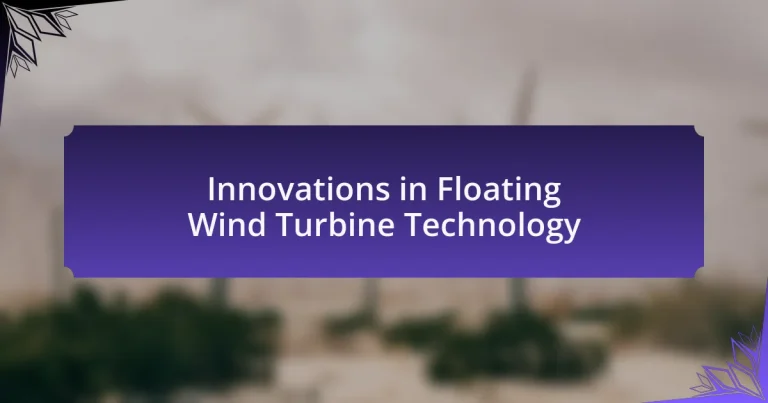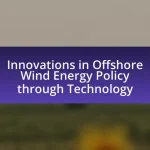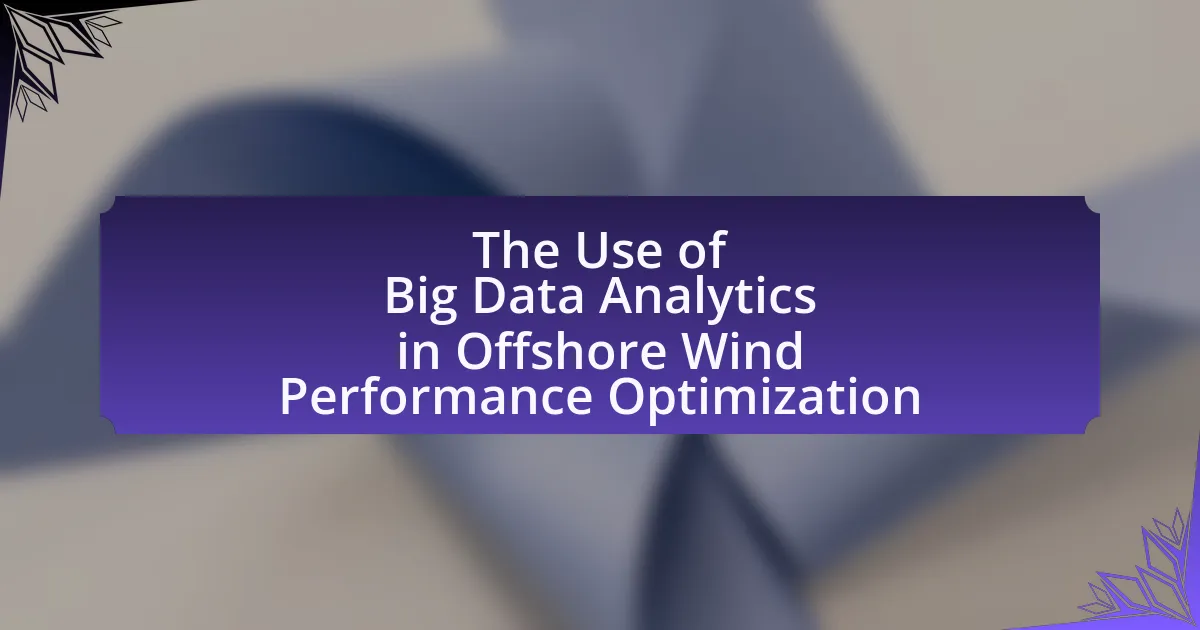Innovations in floating wind turbine technology encompass advancements in design, materials, and deployment strategies that enhance efficiency and reduce costs. Key features include buoyant platforms, advanced mooring systems, and larger rotor assemblies, enabling turbines to operate in deeper waters with stronger wind resources. Recent developments demonstrate that floating wind farms can generate significantly more energy than traditional fixed-bottom turbines, supported by successful pilot projects globally. The article also addresses the environmental impacts, economic barriers, and future trends in this rapidly evolving sector, highlighting the importance of material science and automation in improving the viability of floating wind energy as a renewable resource.
What are Innovations in Floating Wind Turbine Technology?
Innovations in floating wind turbine technology include advancements in design, materials, and deployment strategies that enhance efficiency and reduce costs. Recent developments feature the use of lightweight composite materials that improve buoyancy and structural integrity, allowing turbines to operate in deeper waters where wind resources are stronger. Additionally, dynamic positioning systems have been introduced to maintain turbine stability in challenging marine environments. These innovations are supported by research indicating that floating wind farms can generate up to 50% more energy compared to traditional fixed-bottom turbines, making them a viable solution for meeting renewable energy targets.
How do floating wind turbines differ from traditional wind turbines?
Floating wind turbines differ from traditional wind turbines primarily in their installation method and operational environment. Traditional wind turbines are typically anchored to the seabed or land, while floating wind turbines are mounted on floating platforms that allow them to be deployed in deeper waters where wind resources are often stronger and more consistent. This capability enables floating turbines to access offshore locations that are not feasible for fixed-bottom turbines, thereby expanding the potential for renewable energy generation. Floating wind technology has been validated through various pilot projects, such as the Hywind Scotland project, which demonstrated the viability of floating turbines in deep water conditions.
What are the key design features of floating wind turbines?
The key design features of floating wind turbines include a buoyant platform, anchoring systems, and a rotor assembly. The buoyant platform allows the turbine to remain stable and operational in deep waters, where traditional fixed-bottom turbines are not feasible. Anchoring systems, such as catenary or tension leg designs, secure the turbine to the seabed, providing stability against wind and wave forces. The rotor assembly is typically designed to optimize energy capture in varying wind conditions, often featuring larger blades to harness more wind energy. These design elements collectively enhance the efficiency and viability of floating wind turbines in offshore environments.
Why is buoyancy important in floating wind turbine technology?
Buoyancy is crucial in floating wind turbine technology because it enables the turbines to remain stable and upright in water, allowing them to harness wind energy effectively. The design of floating wind turbines relies on buoyant structures that support the turbine above the water surface, preventing submersion and ensuring operational efficiency. For instance, the use of spar-buoy or semi-submersible platforms provides the necessary buoyancy to withstand ocean waves and currents, which is essential for maintaining the turbine’s position and maximizing energy capture.
What advancements have been made in floating wind turbine technology?
Recent advancements in floating wind turbine technology include the development of larger turbine sizes, enhanced mooring systems, and improved energy conversion efficiency. These innovations allow for the deployment of turbines in deeper waters, where wind resources are typically stronger and more consistent. For instance, the introduction of floating platforms like the WindFloat and Hywind has demonstrated the capability to support turbines exceeding 10 MW, significantly increasing energy output. Additionally, advancements in materials and design have led to more robust and stable floating structures, reducing maintenance costs and increasing operational lifespan. These developments are supported by successful pilot projects and ongoing research, indicating a promising future for floating wind energy as a viable renewable resource.
How has material science contributed to floating wind turbine innovations?
Material science has significantly advanced floating wind turbine innovations by developing lightweight, durable materials that enhance structural integrity and efficiency. For instance, the use of advanced composites, such as carbon fiber reinforced polymers, has reduced the weight of turbine components while maintaining strength, allowing for larger rotor diameters and improved energy capture. Additionally, innovations in corrosion-resistant coatings have extended the lifespan of floating platforms in harsh marine environments, ensuring reliability and reducing maintenance costs. These material advancements have been crucial in enabling the deployment of floating wind turbines in deeper waters, where traditional fixed-bottom turbines are not feasible, thus expanding the potential for renewable energy generation.
What role does automation play in the development of floating wind turbines?
Automation plays a crucial role in the development of floating wind turbines by enhancing efficiency, reliability, and safety during both construction and operation. Automated systems facilitate precise positioning and installation of turbines in challenging offshore environments, reducing human error and labor costs. For instance, advanced robotics and drones are employed for site surveys and maintenance, allowing for real-time monitoring of turbine performance and environmental conditions. This integration of automation not only accelerates deployment timelines but also improves energy output by optimizing turbine alignment and performance adjustments based on data analytics.
What are the environmental impacts of floating wind turbine technology?
Floating wind turbine technology primarily impacts the environment through its effects on marine ecosystems, visual aesthetics, and potential noise pollution. The deployment of floating wind turbines can disrupt local marine habitats, particularly during installation, as it may affect seabed organisms and fish populations. Research indicates that the presence of turbines can alter local marine biodiversity, with studies showing changes in species composition around offshore wind farms. Additionally, the visual impact of floating wind turbines can affect coastal landscapes, potentially influencing tourism and local communities. Noise generated by the turbines may also have implications for marine life, particularly for species that rely on sound for communication and navigation. Overall, while floating wind turbines contribute to renewable energy generation, their environmental impacts necessitate careful consideration and management.
How do floating wind turbines affect marine ecosystems?
Floating wind turbines can significantly impact marine ecosystems by altering habitats, affecting local wildlife, and influencing water quality. The installation of these turbines can lead to changes in seabed structures, which may disrupt benthic organisms and their habitats. Additionally, the presence of floating wind turbines can attract marine species, potentially leading to changes in local biodiversity and predator-prey dynamics. Research indicates that the noise generated during construction and operation can affect marine mammals and fish behavior, potentially leading to displacement or changes in migration patterns. Furthermore, the introduction of artificial structures can create new habitats for certain species, which may benefit some while harming others.
What measures are taken to minimize environmental disruption?
Floating wind turbine technology employs several measures to minimize environmental disruption. These measures include careful site selection to avoid ecologically sensitive areas, the use of advanced anchoring systems that reduce seabed disturbance, and the implementation of noise reduction technologies during installation and operation. Additionally, environmental impact assessments are conducted prior to deployment to identify and mitigate potential risks to marine life and habitats. These practices are supported by studies indicating that responsible siting and technology can significantly lessen the ecological footprint of offshore wind energy projects.
How is floating wind turbine technology being implemented globally?
Floating wind turbine technology is being implemented globally through various pilot projects and commercial installations in regions with deep waters, where traditional fixed-bottom turbines are not feasible. Countries like Norway, Scotland, and Japan have launched significant initiatives; for instance, Norway’s Hywind project, the world’s first floating wind farm, began operations in 2017 and has demonstrated the viability of this technology. Additionally, the Kincardine floating wind farm in Scotland, with a capacity of 50 MW, showcases the growing trend of utilizing floating platforms to harness wind energy in deeper waters. These implementations are supported by advancements in engineering and materials, enabling the construction of stable and efficient floating structures that can withstand harsh marine conditions.
What countries are leading in floating wind turbine projects?
The countries leading in floating wind turbine projects are Norway, Scotland, and the United States. Norway has been at the forefront with its Hywind project, which was the world’s first floating wind farm, launched in 2009. Scotland is also a key player, hosting the Kincardine floating wind farm, which is the largest of its kind, with a capacity of 50 MW. The United States is emerging in this sector, particularly with projects like the WindFloat Atlantic, which showcases significant advancements in floating technology. These countries are recognized for their investments and developments in floating wind energy, contributing to the growth of this innovative technology.
How do government policies influence the adoption of floating wind turbines?
Government policies significantly influence the adoption of floating wind turbines by providing financial incentives, regulatory frameworks, and research funding. These policies can lower the cost of investment and operational risks associated with floating wind projects, making them more attractive to developers. For instance, countries like Norway and Scotland have implemented specific subsidies and tax breaks for offshore renewable energy projects, which have directly led to increased investments in floating wind technology. Additionally, streamlined permitting processes and supportive legislation can accelerate project timelines, further encouraging the deployment of floating wind turbines.
What challenges does floating wind turbine technology face?
Floating wind turbine technology faces several significant challenges, including high costs, technical complexity, and environmental concerns. The installation and maintenance of floating turbines are more expensive than traditional fixed-bottom turbines due to the need for specialized vessels and equipment. Additionally, the engineering challenges associated with anchoring and stabilizing turbines in deep water require advanced technology and design solutions. Environmental concerns arise from potential impacts on marine ecosystems and navigation, necessitating thorough assessments and regulatory compliance. These factors collectively hinder the widespread adoption and scalability of floating wind turbine technology.
What are the economic barriers to widespread adoption?
The economic barriers to widespread adoption of floating wind turbine technology include high initial capital costs, limited access to financing, and uncertain return on investment. High initial capital costs arise from the advanced materials and technology required for floating structures, which can exceed traditional fixed-bottom turbines. Limited access to financing is often due to the perceived risks associated with new technologies, making investors hesitant. Additionally, uncertain return on investment stems from fluctuating energy prices and the nascent stage of the floating wind market, which complicates long-term financial projections. These factors collectively hinder the scalability and deployment of floating wind turbine projects.
How do technical challenges impact the efficiency of floating wind turbines?
Technical challenges significantly reduce the efficiency of floating wind turbines by affecting their operational stability and energy output. Issues such as mooring system failures, dynamic positioning, and structural integrity can lead to increased downtime and maintenance costs, ultimately decreasing the overall energy generation capacity. For instance, a study by the National Renewable Energy Laboratory found that improper mooring can result in a 20% reduction in energy capture due to misalignment with wind direction. Additionally, the complex interactions between the floating platform and environmental conditions, such as waves and currents, can further complicate performance, leading to inefficiencies in energy conversion.
What future trends can we expect in floating wind turbine technology?
Future trends in floating wind turbine technology include increased deployment in deeper waters, advancements in turbine design for higher efficiency, and enhanced materials for improved durability. The shift towards deeper waters allows access to stronger and more consistent wind resources, which can significantly boost energy output. Innovations in turbine design, such as larger rotor diameters and improved aerodynamics, are expected to enhance energy capture and reduce costs. Additionally, the use of advanced composite materials and floating platform designs will likely lead to longer operational lifespans and reduced maintenance needs, as evidenced by ongoing projects and research in the sector.
How might advancements in energy storage affect floating wind turbines?
Advancements in energy storage can significantly enhance the efficiency and reliability of floating wind turbines. Improved energy storage technologies, such as lithium-ion batteries and flow batteries, enable the capture and storage of excess energy generated during peak wind conditions, allowing for a more consistent energy supply even when wind speeds are low. For instance, integrating advanced energy storage systems can help mitigate the intermittent nature of wind energy, leading to a more stable output that aligns with grid demand. This capability is crucial as floating wind farms are often located in remote areas where energy transmission can be challenging. Enhanced energy storage solutions can also facilitate better load management and reduce reliance on fossil fuels, contributing to a more sustainable energy ecosystem.
What innovations are on the horizon for floating wind turbine design?
Innovations on the horizon for floating wind turbine design include advanced materials, improved anchoring systems, and enhanced energy conversion technologies. Advanced materials, such as lightweight composites, are being developed to reduce the overall weight of turbines, allowing for larger structures that can capture more wind energy. Improved anchoring systems, including dynamic positioning and tension leg platforms, are being designed to enhance stability and reduce installation costs. Additionally, innovations in energy conversion technologies, such as more efficient turbine blades and direct drive systems, are expected to increase energy output and reduce maintenance needs. These advancements are supported by ongoing research and development efforts in the renewable energy sector, aiming to make floating wind turbines more efficient and economically viable.
What best practices should be followed in floating wind turbine projects?
Best practices in floating wind turbine projects include thorough site assessment, robust design and engineering, effective stakeholder engagement, and comprehensive environmental impact studies. Conducting a detailed site assessment ensures that the location is suitable for floating wind technology, considering factors such as water depth, wind patterns, and seabed conditions. Robust design and engineering practices are essential to withstand harsh marine environments, which can be validated by standards set by organizations like the International Electrotechnical Commission (IEC). Effective stakeholder engagement, including local communities and regulatory bodies, fosters collaboration and addresses concerns, which is critical for project acceptance and success. Lastly, comprehensive environmental impact studies help identify and mitigate potential ecological effects, aligning with guidelines from the International Maritime Organization (IMO) and ensuring compliance with environmental regulations.




